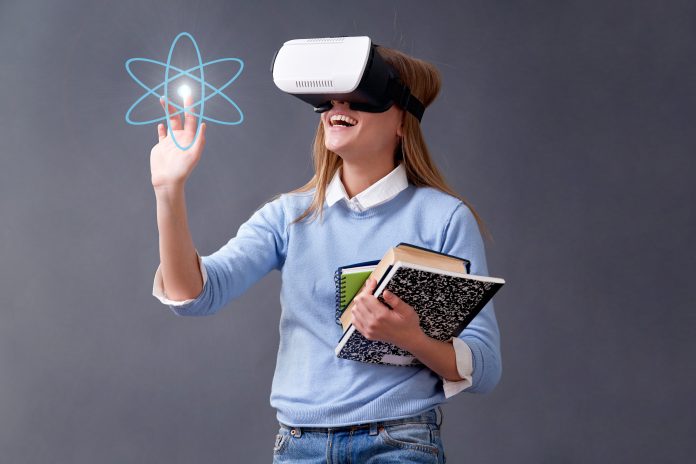Virtual reality technology has been around for quite some time, but it is only recently that it has begun to revolutionize the way we learn. With the ability to create immersive and interactive environments, virtual reality has the potential to transform traditional learning methods and make them more engaging and effective. In this blog post, we will discuss the different ways in which it can be implemented to enhance the learning experience. Whether you are a student, teacher, or simply interested in the future of education, this post is for you. Read On!
 |
| Augmented and Virtual Reality. Image Source :openaccessgovernment | |
Virtual reality (VR) has been increasingly adopted in various industries, including education and learning. The use of VR technology in education provides a unique opportunity for students to interact with complex concepts and environments that would otherwise be difficult to access. Moreover, the use of VR in education can enhance student engagement and motivation, leading to improved learning outcomes.
One of the most significant benefits of using VR
in education is that it offers students an immersive and interactive learning
experience. For example, students can explore virtual environments and interact
with 3D models, which helps to bridge the gap between theoretical concepts and
real-world applications. This type of learning can be particularly beneficial
for STEM subjects, where students often struggle to visualize complex concepts.
Another benefit of VR in education is that it
allows students to learn at their own pace. Students can repeat challenging
tasks until they feel comfortable with the material, and they can also receive
instant feedback on their progress. This approach to learning can help to
reduce the frustration and anxiety that students often experience when learning
new subjects.
Despite the many benefits of VR in education,
there are still some challenges that need to be addressed. For example, VR
technology can be expensive to implement, and not all schools have the
resources to invest in this technology. Additionally, there is a lack of
research on the long-term effects of using VR in education.
To sum up, VR has the potential to revolutionize the way we teach and learn. While there are still challenges to overcome, the benefits of using VR in education are significant. As technology continues to evolve, it will be interesting to see how VR is integrated into the classroom and how it impacts student learning outcomes.
How Can We Integrate Virtual Reality into
the Learning Environment?
Virtual reality (VR) is a technology that is transforming the way we learn. It creates a simulated environment that allows us to experience things in ways that were once impossible. Integrating virtual reality into the learning environment has many benefits, including increased engagement, better retention of information, and more personalized learning experiences.
Here are Top 10 ways to integrate virtual reality into the learning environment
- 1.
Virtual
field trips: Take students on a virtual field trip to places they might not
otherwise be able to visit, such as the depths of the ocean or the surface of
Mars.
- 2.
Interactive
simulations: Use VR to create interactive simulations that allow students to
experiment with different scenarios, such as designing a rollercoaster or
exploring a historical event.
- 3.
Language
immersion: Use VR to create immersive language learning experiences that
simulate real-world situations.
- 4.
Anatomy
and biology lessons: Use VR to explore the human body and biology in a way that
is more engaging and interactive than traditional textbooks.
- 5.
Historical
reenactments: Use VR to recreate historical events, such as the signing of the
Declaration of Independence or the Battle of Gettysburg.
- 6.
Safety
training: Use VR to train employees on safety procedures in a simulated
environment, reducing the risk of accidents.
- 7.
Engineering
and design: Use VR to design and prototype new products, allowing for more
efficient and cost-effective development.
- 8.
Soft
skills training: Use VR to train employees on soft skills, such as public
speaking and conflict resolution, in a safe and controlled environment.
- 9.
Mental
health therapy: Use VR to provide therapy for mental health issues, such as
anxiety and PTSD.
- 10. Art and creativity: Use VR to explore and create art in a new and immersive way, allowing for more creativity and expression.
Integrating virtual reality into the learning environment is a growing trend that is set to revolutionize the way we learn. By providing engaging and immersive experiences, students and employees can learn more effectively and efficiently. With the technology becoming increasingly accessible and affordable, it is only a matter of time before VR becomes a standard tool in the classroom and workplace
References
- Johnson, L., Adams Becker, S., Cummins, M., Estrada, V.,
Freeman, A., and Ludgate, H. (2016). NMC Horizon Report: 2016 Higher
Education Edition. The New Media Consortium.
- Ouyang, Y., Chen, N., and Zhou, W. (2019). The Effects of
Virtual Reality on Learning Outcomes: A Meta-Analysis. Educational
Research Review, 27, 244-260.
- Pivec, M. (2014). Games, gamification, and game-based
learning: A review. International Journal of Emerging Technologies in
Learning, 9(6), 52-59.
- The Benefits of Virtual Reality in Education", Forbes
- "10 Ways Virtual Reality is Revolutionizing Education
and Training", eLearning Industry
- "Virtual Reality in the Classroom", EdTech Magazine
Comments
Post a Comment